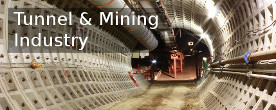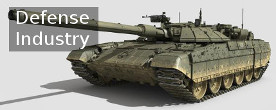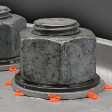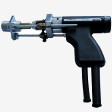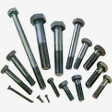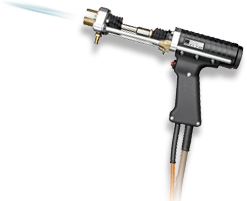Why Use Squirter® DTIs
Because DTIs are completely independent of the bolt's torque resistance, they are the simplest, most cost effective method of bolting quality assurance.
There are four and only four methods allowed to measure whether structural bolts are correctly installed. When used correctly, all four methods will produce correctly tensioned bolts, but all four methods differ in complexity and effectiveness. Because DTIs are the simplest and because they are torque independent, many construction professionals consider DTI's the best. See what the Pros have to say.
But you should decide for yourself. Whatever your role in the project team, we'll show you how DTIs work to your benefit. Click on what you do, then see what DTIs do for you!
Inspector Benefits
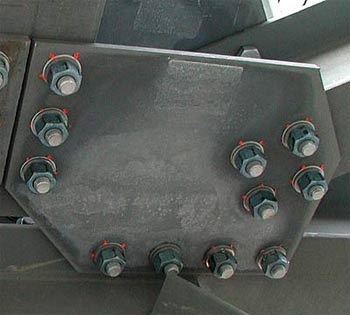
When SQUIRTER® DTIs are used, the inspector's work drops substantially.
Just look at this typical connection that has been done with SQUIRTER® DTIs. The inspector can tell from ten feet away which bolts have been done, and, look carefully, which have not. No feeler gage!
When DTI's are used, inspectors don't have to lug around a big torque wrench up on the steelwork, and try to keep from falling while measuring a lot of meaningless torques. Instead, they just carry a little feeler gage in their pocket and check about 10% of the compressed DTI's to see if the DTI bumps have been compressed sufficiently. And because there is a DTI on every bolt in the connection, the real inspection tends to be done by the bolt installer, which is who should do it anyway. Instead of grunting on a torque wrench, and in effect correcting all the erector's not-quite-tight bolts, inspectors can concentrate on inspecting other items requiring their attention.
For some types of structures, for example bridge connections with many hundreds of bolts, or conections containing many large diameter high strength bolts, DTI's really are the only way that inspection can be accomplished at all.
Erector Benefits
What erectors tell us is this - "If we're going to get inspected seriously, DTI's are the preferred method."
What they mean by this is that if they know the steel inspectors are really going to enforce the specified procedures for calibrated wrench or turn-of-nut, or field test twist-off bolts in their weathered condition "as-installed", it's just easier for them to put a DTI on the bolt, snug the joint, "squash" the DTI's, and get on with the next connection. Once an erector has squashed the DTI, no one can say that he or she has not done the job correctly. There's no torque wrench inspection, and no arguments about torque inspection values and how to interpret them.
With SQUIRTER® DTIs, erectors now go fast. SQUIRTER® DTIs are now LOVED by erectors, whereas regular non-squirting DTI's have sometimes given them heartache.
Erectors tell us they save more in time costs than the SQUIRTER® DTIs cost, and consequently erection firms are coming directly to Applied Bolting and requesting that we help them get SQUIRTER® DTIs approved for use on their projects, EVEN WHEN NO DTI'S HAD BEEN SPECIFIED.
Dick Construction, V&M Erectors, Wood Hopkins Erectors, Babcock Wilcox Construction Company, Fluor Daniel Constructors, Bechtel Construction Company, are just a few.
Designer Benefits
Structural steel designers are not in the business of taking chances with their creations. They know that some structures can be assembled with loose bolts, 'snug tight' bolts or A307 bolts, and no distress would ensue. But they also know that some structures need correctly pretensioned bolts to keep the faying surfaces in firm contact and to resist the design service and ultimate loads.
DTI's fulfill the requirements of the "special inspection" provisions of ICBO, which are often required to be satisfied on particular connections which ICBO stipulates must be correctly assembled and checked.
Just about all connections on structural steel are governed by the Research Council on Structural Connections. According to the Research Council on Structural Connections (RCSC), the "contract documents" (read "design drawings") must show the "Joint Type" - either snug-tight, pretensioned, or slip-critical.
Designers know that the following types of connections require full pretension in the bolts:
- All bridges.
- All slip-critical connections. (The Research Council on Structural Connections states the connection must be designed as "slip-critical" where slip would be detrimental to the behavior of the joint, where the joint will experience fatigue or significant load reversal, joints with oversized or slotted holes, where welds and bolts are used together, and where the bolts are used in direct axial tension) (Revised in the 2000 RCSC to say you really don't have to tension all bolts used in pure tension if statically loaded) .
- Where the bolts are considered to be in the category of "pre-tensioned shear/bearing", they must also be fully pretensioned, although the degree of inspection for bolt tension is not mandated. (In the 2000 RCSC Spec inspection is mandated)
- Where the faying surfaces are coated and the design calls for transfer of loads by friction, the joint surface must be qualified and the bolts must be fully pretensioned also.
- Most engineers require correctly tensioned bolts in connections supporting moving machinery, connections governed by seismic loads, connections between the members of a wind resisting system, moment connections, connections in steel which shares load with concrete members, in roof truss splices, in roof truss bracing and connections of roof trusses to their columns, where the prying load on arrays of bolts is high or indeterminate, where the fit between members is or is suspected to be poor (read pre-engineered end plate connections), and in connections of frames having a high slenderness ratio. The AISC LRFD Spec now states that built-up compression members must also have fully pretensioned bolts so that their slenderness ratio is predictable.
The design engineer has to decide whether DTI's should be specified as the ONLY bolt installation quality assurance method on the fully pretensioned bolts, just as decisions on paint quality or steel grade or welding procedure must be made. Often the decision is yes. Leaving the decision of whether or not to use DTI's up to the other members of the construction team will often result in shortcuts being taken in bolting. Designers are not paid to take chances that something MIGHT be constructed correctly, and specifying DTI's sends a message to the trades that the design is important. Designers usually acknowledge that DTI's produce higher and more consistent bolt tensions than any other method, and if that is what is needed on all or part of a structure, then they should be specified.
DTI's do not affect the overall cost of a steel frame because the cost of bolting inspection is reduced. In fact, when SQUIRTER® DTIs are used, it has been demonstrated that the bolt installation and inspection cost is reduced, by about $1.00 per bolt, by one measurement. Click here to see the trial study results
Occasionally designers must justify the cost (see Total Installed Cost) of DTI's to the project owner, because, as an added item to purchase, their cost is identifiable, although small. At 15 bolts to the ton of steelwork, DTI's add about $7.50/ton to the $1500 to $2000 per ton cost of steelwork, or less than one half of one percent. When DTI's are specified for only some of the connections in a structure, the cost of them becomes even smaller.
Torque wrench inspection and part-turn inspection is unnecessary when DTI's are used, saving $5.00 to $8.00 per ton. That's why we can say that, overall, the owner will not pay any premium (see Total Installed Cost) when DTI's are used, often less.
Designers should carefully consider the use and specification of SQUIRTER® DTIs, because they save money and improve constructability.
Owner Benefits
Project owners often take an interest in whether DTI's are incorporated into their structures because they know that properly tensioned bolts are important for their structures. Many owners recognize that the quality of the bolting that DTI's provide really comes at NO EXTRA COST, AND WITH SQUIRTER® DTIs, NOW AT A NET SAVINGS TO THEM! Dozens of owners report that their cost/benefit analysis of the effect of adding SQUIRTER® DTIs to the job comes out favorably!
Examples of owners:
- Roller coaster manufacturers
- Precipitator and scrubber builders - (vibratory loads)
- Constructors who build process or especially power plants in locations where the skill level of bolt installers is suspect
- Process plant owners who prefer to use galvanized bolts and whose experience tells them that galvanized bolts are particularly difficult to tighten correctly
- Bridge owners whose prime responsibility is to make sure ALL the bolts get tightened correctly and who do the inspection with their own forces
- Sign support owners who often must rely on unskilled labor to assemble their structures
- The U.S. Military who prefer DTI's over all other allowable quality control procedures
Detailers
Detailer are generally indifferent as to whether DTI's or SQUIRTER® DTIs are going to be used. If the design calls for DTI's there are a few matters that the detailer must address, however.
1. Bolt Length: DTI's don't change the ordered length of bolts because all bolts are sized to have a few threads sticking through the nut, and the DTI takes up less than the length of two threads. DTI thickness is shown on the chart located under manufacturing specifications For more detailed information on DTI's and bolt lengths please see this FAQ
2. Flat Washer Requirements: for more on flat washer requirements:
- APPLICATION ADVISORY: Flat Washer Requirements Chart
- APPLICATION ADVISORY: Hot Dip Galvanizing of Flat Washers Caution
- APPLICATION ADVISORY: 1 1/4" diameter A490 Bolts in oversized holes
- FAQ: DTIs compress but no squirt event
- FAQ: Flat Washer Requirements
- EDRAWINGS
3. .DWG / .DXF AutoCAD files for Structural Steel Detailers: you can put them on your project drawings, then annotate them a little, which then tells bidders of that project to expect DTI's on the bolts and how to install them.
Click Here For DWG / DXF files for Detailers
Fabricator Benefits
In the US at least, the fabricator does not actually do field bolting, but the fabricator does purchase the bolts and bolting hardware and supplies all of it to the erector. Usually what the fabricator wants to achieve therefore is the least expensive first cost for bolting hardware. For this reason, since DTI's are an extra piece of hardware they have to purchase, fabricators sometimes resist their use. Knowledgeable fabricators know that DTI's CAN save money in a couple of specific situations, however.
One situation is where the erector wants to use twist-off bolts of 1" diameter or larger, especially in the A490 grade. Here the use of regular hex head bolts with a DTI can save considerable money, around $1.00 per bolt or more.
In December of 2001, a major bolt distributor quoted about 150,000 1 1/8" A490 twist-off bolts, and also quoted A490 hex bolts with DTI's. The hex bolts with DTI's were quoted at $1.90 less ($5.40 vs $3.50).
EPC Contractor Benefits
EPC means "Engineering, Procure, Construct". These are companies like Bechtel, Fluor Daniel, Foster Wheeler, Black & Veatch, Kellogg/Brown and Root, Parsons, Raytheon, etc. These are the companies that are responsible for all facets of the project, even for operating it prior to turning it over to the owner. Time, efficiency, reliability, and quality are very important, but most important is CONSTRUCTABILITY.
EPC contractors have embraced SQUIRTER® DTIs with a vengence. Making the whole bolting process simpler and more efficient is what these companies are all about. Field bolting can consume 20 to 30 percent of the field labor to construct steelwork, and a 25 percent saving in this labor quickly adds up, they report.
How do DTI's improve constructability?
- One-side, one-man bolt tightening, saves labor cost.
- No torque wrench inspection, saves inspection cost.
- Higher more consistent bolt preload, because DTI's are not controlled by torque.
- Bolt quality checked - very important when the source of bolts is suspect.
- No part-turn procedure to verify on every bolt as when turn-of-nut is used.
- DTI's function correctly whatever the condition of the bolts and nuts.
- Allows metric bolt installation - there are no approved part-turn procedures for metric bolts.
- DTI's are manufactured to suit any bolt made in the world.
- Proves to Owner that the bolting has been done correctly, even if it was done by low skilled workers in foreign countries.
- DTI's function correctly when the steelwork is hot dipped galvanized, even though the zinc surface is compressible. DTI's are the only tightening method which will work correctly in this situation.
OEM Builder Benefits
Companies like Siemens Westinghouse, Hamon Research Cottrell, Boeing, FMC Jetway, want to tighten bolts uniformly and to a specific TENSION, not torque.
Until DTI's came along to use instead of torque, torque was all they had to work with, and still they use torque in many situations. But increasingly companies like these want to install to a uniform clamping force, and to do that with DTI's is easy, and far more accurate than torque. They just close the DTI by tightening the bolt in logical stages until the residual DTI gap is just right. Then they've got a specific bolt tension, regardless of bolt length, quality, diameter, and condition. And their repair depots can do the very same thing too, with a DTI, because it's simple and independent of torque. Some of these applications are now into using SQUIRTER® DTIs, just making the DTI squirt and then rotating the nut a known rotation more. Non-typical bolt preloads are usual, and can be accommodated by the DTI's.
These companies realize that a high uniform clamping force in a well-designed connection is usually the very best insurance against bolt loosening in service.
See a brief powerpoint presentation on our development of a custom Squirter® for the M36 DIN 6914 bolts used in many wind turbine shafts HERE
Squirter® DTIs and Constructability
Bolting can consume 30 percent of all field labor to erect steelwork. Inspection labor would be in addition to this.
Technologies make a lot of sense that reduce field installation and inspection labor, and that's what constructability is all about.

Here's a calculation relevant to bolting that illustrates this:
The loaded labor cost on a power plant is (say) $50.00 per man-hour, and field bolting is accomplished at 15 bolts per man-hour. Each bolt therefore costs $50/15 or $3.33 to install. A 20% improvement in overall bolting efficiency would therefore save $0.66 per bolt. The added cost of a Squirter® DTI will be about $0.20 per bolt if regular non-squirting DTI's were to be used, or $0.60 if no DTI were otherwise to be used.
Therefore, if the addition of a DTI or Squirter® DTI allows a 20% improvement in bolting efficiency, then the benefit-to-cost ratio is positive, and "constructability" is enhanced.
In the words of a Construction Coordinator of the largest EPC industrial and power contractor in the world, a company that has specified more than four million Squirter® DTI's,
"...The benefits are numerous. Installation is faster, rework almost nonexistent and inspection a breeze. No more marking of bolts for the turn-of-the-nut method, no more feeler gages, etc. Craft can easily see the silicone, when it squirts out, during the installation assuring that they have achieved the required tension. Field engineers and inspectors can easily see the bright orange squirts from almost anywhere (no need for manlifts or climbing scaffolding to check with feeler gages."

 Surecon Fastening
Surecon Fastening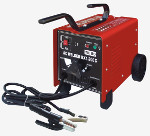 Welding Machines
Welding Machines Köco Stud Welding
Köco Stud Welding




